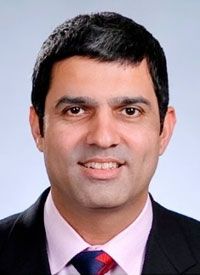Article
Study Exclusion Criteria Limits Real-World Benefit of Immunotherapy in Lung Cancer
Author(s):
Mohammad Jahanzeb, MD, shares the challenges of real-world eligibility for immunotherapy in lung cancer and beyond.
Mohammad Jahanzeb, MD

Mohammad Jahanzeb, MD
Immunotherapy has emerged as a frontline option for patients with metastatic non—small cell lung cancer, but it is important to note that patients eligible for these trials account for a small portion of all patients with lung cancer, said Mohammad Jahanzeb, MD.
Specifically, there are strict eligibility criteria for immunotherapy trials, especially in lung cancer, Jahanzeb explained. Age, autoimmune disease, organ transplantation, and drug addiction are among a list of factors that would make a patient ineligible for enrollment in a clinical trial evaluating the use of an immune-oncology drug.
As such, these patients may miss out on a potential survival advantage, he said.
“Immunotherapy is an integral part of our paradigm. It is what platinum-based chemotherapy used to be—the backbone of all therapy,” said Jahanzeb. “We cannot think of frontline therapy in lung cancer without thinking of immunotherapy. Unless someone has an absolute contraindication to immunotherapy, we would strongly consider using it.”
OncLive: What are some important exclusion criteria in clinical trials for immunotherapy?
In an interview with OncLive, Jahanzeb, professor of Clinical Medicine, Hematology/Oncology, Sylvester Comprehensive Cancer Center, at University of Miami Miller School of Medicine, shared the challenges of real-world eligibility for immunotherapy in lung cancer and beyond.Jahanzeb: Clinical trials have very strict criteria when we think of immunotherapy. Investigators specifically do not want to anger an immune system that is already angry. Naturally, [this includes] patients with autoimmune disease, those who have solid organ transplantation, and even those who have had bone marrow transplantation and have been immune suppressed, so they do not reject the graft or bone marrow. [All of] those patients would be excluded from these studies. With patients who have had pneumonitis in the past, you cannot afford to put them at risk for severe pneumonitis as a result of immunotherapy—this happens in 2% to 3% of patients, and so, these patients are also excluded.
Then, you look at the general criteria of clinical trials. In every protocol, if a patient has another invasive cancer, they would be excluded because you do not want to cause confusion in the body. You want a pure population. You would also exclude patients with poor performance status, abnormal lab [results], and poor organ function. We have a bias against the elderly patients, even though the politically correct way to do it is to not put an age limit [on enrollment]. We used to, and it was fair game about 2 decades ago. I recall the pivotal trial that led to the approval of chemotherapy in lung cancer—the upper age limit in that study was 70. We cannot put a number in there now, but we all seem to have these biases about age. We need to focus on physical age, not the calendar age.
Could you expand on age as an exclusion factor?
Are patients with driver mutations excluded from these trials?
This is not an exhaustive list, but patients with HIV, hepatitis, and psychiatric conditions or drug addictions would also be excluded [from trials]. We need patients to be compliant. At the end of the day, only about 4% of adult patients are treated on clinical trials in the United States as opposed to nearly 90% of pediatric patients who go on protocols.Age is a moving target. There was a time where everybody agreed that 65 [years] was the line between elderly and nonelderly; this may be because it corresponds with the Medicare eligibility age. Now, studies have gone up to 70 [years] or even older. Interestingly, when you look at patients older than 65 [years], efficacy with immunotherapy seems to be better. This is partly because you have more patients in that subset. The median age of patients with lung cancer is 68, so the majority would be what we consider elderly.Driver mutations are an interesting subset of patients because I believe—and now, data supports it—that carcinogen-induced cancers, which are caused by sunlight or smoking, are ugly tumors. They have a high tumor mutational burden. This means a sleeping immune system can wake up and more readily recognize these ugly features; it attacks them. Chemoimmunotherapy is much more effective there.
Are there ways to gather data from the patients being treated with immunotherapy in the real-world setting?
However, these pristine-looking cells that have just 1 thing wrong with them, 1 mutation driving the cancer, they are more difficult to recognize by the immune system. Immunotherapy has not worked in those patients. Perhaps later on, after we have exhausted TKIs and PD-L1 [expression] has gone up—that is a different situation. Recent studies have shown some efficacy with immunotherapy, but it is clearly not the first choice for the frontline or second-line treatment of these patients.We should be making attempts to do this because only a sliver of patients are treated on clinical trials. We take the information from clinical trials and apply it to everybody. There are efforts like Flatiron Health, which has a big repository of medical records. There are available registries for certain drugs—notably, there is one for bevacizumab (Avastin) and trastuzumab (Herceptin). When you gather data from those registries, it can be reassuring that [these real-world data are] not very different from clinical trial data. Perhaps we can treat unique patients who are excluded from clinical trials. On the other hand, we could find out that some populations are not to be treated.
The other issue is adverse events (AEs). If a unique event happens in 1 in every 2000 patients, you probably will not capture it in a 1000-patient trial. You may need a database of 5000 patients to find those AEs.









